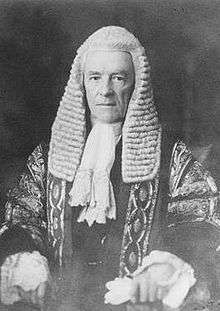Frederic Maugham, 1st Viscount Maugham
| The Right Honourable The Viscount Maugham PC QC | |
|---|---|
 | |
| Lord High Chancellor of Great Britain | |
|
In office 9 March 1938 – 3 September 1939 | |
| Monarch | George VI |
| Prime Minister | Neville Chamberlain |
| Preceded by | The Viscount Hailsham |
| Succeeded by | The Viscount Caldecote |
| Personal details | |
| Born |
20 October 1866 Paris, France |
| Died | 23 March 1958 (aged 91) |
| Nationality | British |
| Political party | Conservative |
| Spouse(s) |
Helen Romer (1872–1950) |
| Alma mater | Trinity Hall, Cambridge |
Frederic Herbert Maugham, 1st Viscount Maugham PC QC (20 October 1866[1] – 23 March 1958[2]) was a British lawyer and judge who served as Lord Chancellor from March 1938 until September 1939.
Background and education
Born in Paris, Maugham was the son of Robert Ormond Maugham by his wife, Edith, daughter of Major Charles Snell. The author W. Somerset Maugham was his younger brother. He was educated at Dover College and at Trinity Hall, Cambridge.[3] He rowed for the winning Cambridge crew in the 1888 Boat Race and was also in the winning Trinity Hall Boat Club coxless four which won the Stewards' Challenge Cup at Henley Royal Regatta that year.[4] He was in the winning Cambridge crew in the Boat Race again in 1889. He also became President of the Cambridge Union Society in Lent Term 1889.[3]
Political and legal career

Maugham was called to the bar by Lincoln's Inn, in 1890, and then embarked upon a legal career, becoming a King's Counsel in 1913. In 1922 he briefly considered entering politics as a Conservative Member of Parliament but could not find a seat. He was a Judge of the High Court of Justice (Chancery Division) from 1928 to 1934 and a Lord Justice of Appeal from 1934 to 1935. He was knighted in 1928 and sworn of the Privy Council in 1934. In 1935 he became a Lord of Appeal in Ordinary, made a life peer and entered the House of Lords as Baron Maugham, of Hartfield in the County of Sussex. Three years later he was offered the position of Lord Chancellor by Prime Minister Neville Chamberlain. Such was Maugham's lack of political experience that Chamberlain and he had never met before. He was offered the role because there were very few obvious available choices amongst the ranks of parliamentary supporters of the National Government to replace the ailing Lord Hailsham, as the obvious successor, Sir Thomas Inskip, could not be moved from the position of Minister for Coordination of Defence.
As Maugham was already 71 years old it was widely expected that he would prove to be a mere stop-gap appointment, to be succeeded by Inskip as soon as it was possible for the latter to leave Defence. However, by the time this occurred in early 1939, Chamberlain was sufficiently impressed with Maugham's work to offer to retain him, whilst allowing Inskip the opportunity to defer choosing between becoming Lord Chancellor and remaining in the House of Commons with the possibility of becoming Prime Minister (a choice that Hailsham had always regretted) and intended to make a change at the next general election, which was expected to take place that year.
However war intervened and Chamberlain carried out a fullscale reconstruction of his government. As part of this Maugham was allowed to retire, to be finally succeeded by Inskip, who was ennobled as Viscount Caldecote. Maugham took the retirement honour of Viscount Maugham, of Hartfield in the County of Sussex, which, unlike his barony, was hereditary. He again served as a Lord of Appeal in Ordinary until 1941.
Family
Maugham married Helen Mary, daughter of Sir Robert Romer, in 1896. They had four children:
- The Hon. Kate Mary Maugham (1897–1961, married Robert Charles Bruce)
- The Hon. Edith Honor Maugham (1901–1996, married Sebastian Earl)
- The Hon. Diana Julia Maugham (1908–2007, married Kenneth Marr-Johnson)[5]
- Robert Cecil Romer Maugham (1916–1981), 2nd Viscount. Known as Robin Maugham. He wrote about his father in two volumes of autobiography, Escape from the Shadows (1970) and Search for Nirvana (1977).
Lady Maugham died in October 1950, aged 78. Lord Maugham survived her by eight years and died in March 1958, aged 91. He is buried in the grounds of the parish church in Hartfield, Sussex, alongside his wife and son.
Publications
- The Case Of Jean Calas published by W. Heinemann (1928)
- The Tichbourne Case (1936)
- The Truth About The Munich Crisis (1944)
- U.N.O. and War Crimes (1951)
- At The End of The Day (autobiography) (1951)
See also
References
- ↑ Cokayne, George (1982). The Complete Peerage of England, Scotland, Ireland, Great Britain, and the United Kingdom, Extant, Extinct, or Dormant. XIII. Gloucester England: A. Sutton. p. 556. ISBN 0904387828.
- ↑ Cokayne, George (1982). The Complete Peerage of England, Scotland, Ireland, Great Britain, and the United Kingdom, Extant, Extinct, or Dormant. Gloucester England: A. Sutton. pp. 725, 742. ISBN 0750901543.
- 1 2 "Maugham, Frederic (MHN885FH)". A Cambridge Alumni Database. University of Cambridge.
- ↑ Denis Larionov & Alexander Zhulin (24 January 2007). "R C Lehmann ''The Complete Oarsman''". Ebooksread.com. Retrieved 3 May 2010.
- ↑ "Diana Marr-Johnson: Obituary". The Times. 18 June 2007. Retrieved 10 October 2011.
External links
- Portraits of Frederic Herbert Maugham, 1st Viscount Maugham at the National Portrait Gallery, London

| Political offices | ||
|---|---|---|
| Preceded by The Viscount Hailsham |
Lord Chancellor 1938–1939 |
Succeeded by The Viscount Caldecote |
| Peerage of the United Kingdom | ||
| Preceded by New creation |
Viscount Maugham 1939–1958 |
Succeeded by Robert Cecil Romer Maugham |
.svg.png)